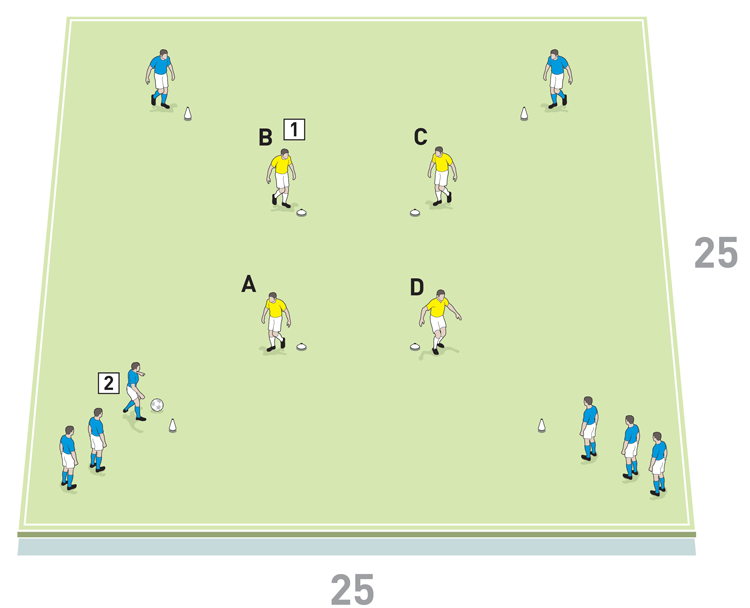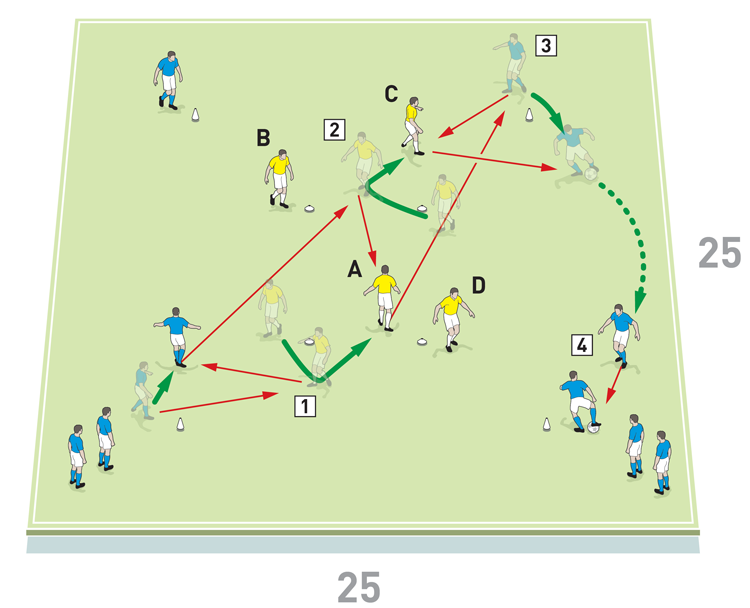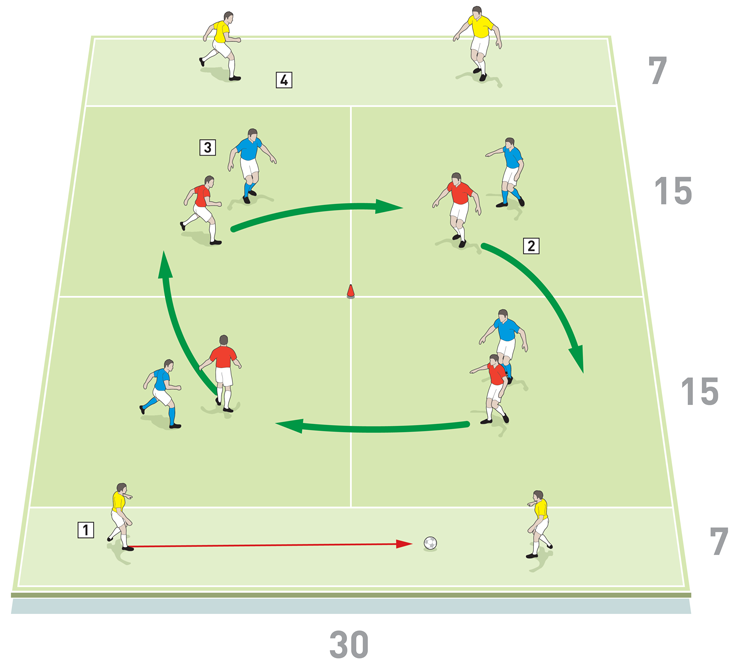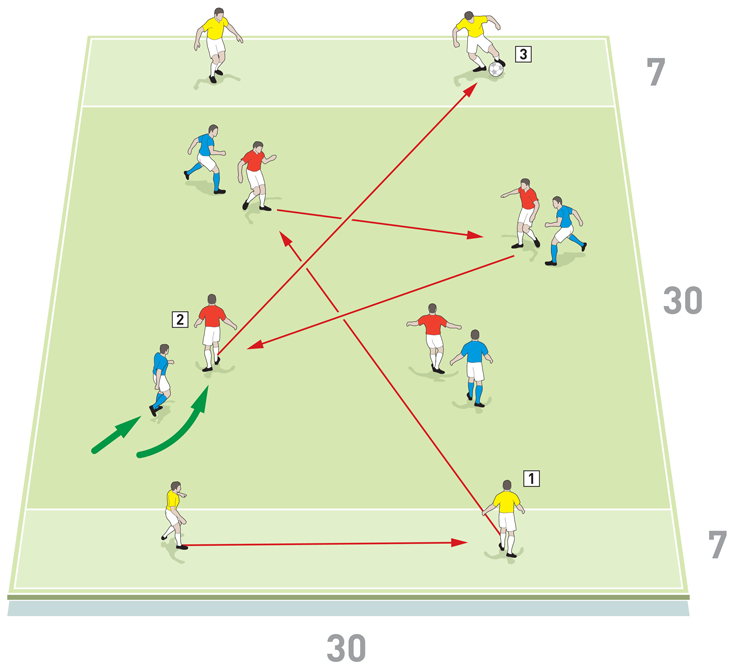You are viewing 1 of your 1 free articles
Improve midfield penetration
Use this session to focus on playing through, and breaking, opposition lines. It is based on keeping possession while looking to make a penetrating pass when possible.
| Area | Up to 44x30yards |
| Equipment | Balls, bibs, cones |
| No. of Players | 12 Players |
| Session Time | Total: 28mins, Passing drill: 10mins, Possession games: 6mins each |
This session is about playing through, and breaking, opposition lines. It is focused around keeping possession while looking to make a penetrating pass when possible.
It challenges the players in terms of their positioning. It also challenges them in terms of their decision-making – on where, when and why to support, and their decision-making and execution in terms of ball circulation.
It demonstrates all the key attacking principles: a. progression; b. offensive coverage (support behind the ball carrier); c. mobility (support ahead of the ball carrier); and d. space (making the pitch big in width and depth).
We use this session regularly at training, usually straight after a warm up. We use it in preparation for a small-sided game or a conditioned game, when the emphasis is around building up and midfield play, especially when working on attacking centrally through an opponent’s midfield.
It is physically demanding and has a strength element to it, as it contains may changes of direction, short accelerations and deceleration in a small space, therefore should be used on game day +3 (or game day –4), so a Tuesday if you play Saturday to Saturday.
What do I get the players to do?
Passing drill
Set up in an area of around 25x25 yards, as shown [1a]. We are using 12 players.
1a

2. The starting blue player uses the yellow supporting players to help get the ball to the blue end player diagonally opposite
The passing sequence is like a figure of eight, with each player moving from station to station, as shown [1b].
1b

2. Support player C passes to support player A
3. Support player A plays the ball long to the end player
4. The end player makes a one-two with C, before dribbling to the next starting station and the sequence begins again sequence begins again from that cone. The player who starts each sequence should replace the end player at the station diagonally opposite.
To make it work properly remember that the support players looking to receive the pass should work in diagonally opposite positions, so if the first support player moves to the right to receive the ball, then the second support player should move to the left to receive. The reason for this is that the support players are always on different vertical and horizontal lines, meaning that in a real game their positioning should challenge the defensive structure of the opponent and create unbalance between units or within a unit.
What do I get the players to do next?
Possession 1: 4v4 stay in zone
This is a possession game with three variations. Set up an area of 44x30 yards that is divided into four 15x15-yard boxes and two seven-yard end zones, one at either end, as shown [2]. Split your players into three team of four: a defending team, an attacking team and a neutral target team. Place a defender and an attacker together in each box (creating a 1v1 in each box) and two target players in each end zone. Players are locked into their areas.
2

2. The ball is passed out to one of the attackers
3. Players must stay in their zones, but the attackers have to keep possession until they find an opening to pass into the end zone
4. The red attackers score by getting the ball to the opposite end zone 5. The target players must pass to each other before starting an attack in the opposite direction
The idea of the game is that the team in possession should combine with each other to play from one side to the other without losing the ball. If they do this, they score a point. As the ball enters the end zone, the receiver must play it across the zone to his team mate before the ball is returned back into the central grids.
The attacking team continues to work the ball from end to end until losing possession, at which point they become the defending team and the defenders become the new attacking team.
As the game is physically demanding, you should rotate the teams every two minutes. Play three games of two minutes, giving each team a turn as target players.
How do I progress the session?
Possession 2: 4v4 rotate
The set-up, organization and rules of this progression are exactly the same as the previous game, but now the attacking team (the team in possession) can now rotate between the four grids (3).
3

2. The attackers can now rotate between the four boxes, but only one attacker is allowed in each box at any point
3. The defenders (the team out of possession) must stay in their zones 4. The end zones also mark offsides, so players must time their runs to make sure they are not caught offside
Play three games of two minutes, giving each team a turn as target players.
Possession 3: 4v4 free in central zone
The set-up is again the same for this final progression (4), but now we take the four boxes out of the central zone and the attackers and defenders now play a 4v4 freely in this space. The principles of the game remain the same and the attackers have to work the ball from one end zone to another without losing possession.
4

2. A free 4v4 is played in the main area
3. The attackers score by getting the ball from one end zone to the other with a penetrating pass
Play three games of two minutes, giving each team a turn in the end zones.
How would you put this into a game situation?
You can use this practice as an introduction to offensive principles that will be present in any small-sided game or 11v11.
What are the key things to look out for?
When in possession, players should consider penetrating centrally through opposition lines, or outside of the block, or even over the block. They should also consider playing first line passes in front of the block, in order to lure the opponent out and create space between lines; or play into the block with second line passes, to make opponents narrower in order to create space on the outside. They could also play third line passes through the block if they can see poor defensive organisation from their opponents.
When out of possession, players should consider freeing themselves from their marker in order to receive the ball and progress, or support play to attract an opponent out of block. Also look for players to support as the third man to receive a set pass behind the opponent’s first defensive line.
Related Files
Editor's Picks
Using the goalkeeper in build-up play
Pressing principles
Intensive boxes drill with goals
Penetrating the final third
Creating and finishing
My philosophy
Pressing initiation
Compact team movement
Defensive organisation
Coaches' Testimonials

Alan Pardew

Arsène Wenger

Brendan Rodgers

Carlos Carvalhal

José Mourinho

Jürgen Klopp

Pep Guardiola

Roy Hodgson

Sir Alex Ferguson

Steven Gerrard
Coaches' Testimonials

Gerald Kearney, Downtown Las Vegas Soccer Club

Paul Butler, Florida, USA

Rick Shields, Springboro, USA

Tony Green, Pierrefonds Titans, Quebec, Canada
Join the world's leading coaches and managers and discover for yourself one of the best kept secrets in coaching. No other training tool on the planet is written or read by the calibre of names you’ll find in Elite Soccer.
In a recent survey 92% of subscribers said Elite Soccer makes them more confident, 89% said it makes them a more effective coach and 91% said it makes them more inspired.
Get Monthly Inspiration
All the latest techniques and approaches
Since 2010 Elite Soccer has given subscribers exclusive insight into the training ground practices of the world’s best coaches. Published in partnership with the League Managers Association we have unparalleled access to the leading lights in the English leagues, as well as a host of international managers.
Elite Soccer exclusively features sessions written by the coaches themselves. There are no observed sessions and no sessions “in the style of”, just first-hand advice delivered direct to you from the coach.









